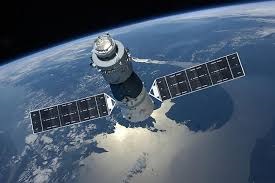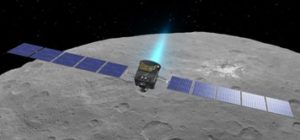Here are the glimpses of space news that was the talk of the town the year 2018.
NASA’s InSight lander detects the sounds of winds of Mars

One of the biggest news of 2018 was the landing of NASA’s newest Mars rover called InSight. Moreover, pretty recently, the agency’s jet propulsion laboratory also released clips of the sounds of winds blowing on the surface of the red planet collected during the first-week of operations by the rover. The estimated speed was around 10 and 15mph and was the very first sound ever captured from Mars that is of low frequency but detectable within human hearing range. It was a rare treat and presented by NASA in a recent news conference. This out-of-the-world sound (literally!) was produced when the winds blew against the solar panels of the rover resulting in vibrations that were recorded by internal sensors. This sensor called the seismometer will soon be moved to the surface of the red planet where it is expected to detect the underground seismic waves that aren’t within the range of human hearing.
A Tesla Roadster launched into space by SpaceX

Another big splash was made in the astronomy world when Elon Musk launched a Tesla Roadster into space through the Falcon Heavy Rocket by SpaceX at a speed of around 18,000mph. The car is currently cruising around the earth and is present in a region of high radiation. The vehicle is expected to roam around in space for millions of years unless destroyed under unexpected circumstances. The car is also equipped with a number of interesting objects. In the driver’s seat, a human mannequin in placed named after the famous David Bowie song “Starman”. There are several songs played in a loop on the car’s sound system which is just a clever gimmick as no one can actually hear it being played in space. In the glovebox, a copy of The Hitchhiker’s Guide to the Galaxy by Douglas Adams is also placed. The vehicle’s circuit board displays the message, “Made on Earth by Humans”.
Soyuz rocket failure forces the astronauts to abort mission

A major mishap that occurred in 2018 was the Soyuz rocket failure that occurred for the first time ever in the history of ISS programme. On Oct 11, 2018, the Russian-American crew on the rocket were forced to conduct an emergency landing after the system suffered a malfunction just minutes after launch into space from the Russian site. Thankfully, the astronauts didn’t suffer any harm and landed safely in Kazakhstan but the incident definitely created an uproar as the Soyuz rocket is known to be the only rocket used to send astronauts to the space station. The launch was smooth at the beginning and the mission was bound to reach the International Space Station (ISS) within the designated time but after 2 minutes the mission controllers reported a failure. Footage from the cabin that was released later, showed objects floating and indicated the problem. Soon, the crew aborted the mission and ejected their capsule. Rescue teams reached the landing site and reported that the crew was safe. After a brief break and investigation, the mission was relaunched and was recently reported to be successful in the first attempt.
A Chinese space station falls into the Pacific Ocean
China’s first prototype space station called Tiangong-1 fell apart on April 1, 2018. It was a part of the country’s ambitious space programme and was originally developed to function until 2013. But it wasn’t decommissioned and its period was extended. However, in the latter part of 2016, reports suggested that it wasn’t under control and may come down sometime during the next two years. China itself predicted 2018 but never specified the time and location as it purely depended on its re-entry. The country’s space agency using its Space Surveillance Network sensor and orbital analysis confirmed that it crashed into the Pacific Ocean in April. The station was designed as a part of the Chinese space programme that is currently working to place their own station in space by 2023. The station was 34 feet long and 11 feet wide weighing more than 9 tons and was composed of an “experimental module” and a “resource module”. The fallen pieces are thought to be of extremely small size contaminated with space junk.
Water found in underground lakes on Mars
Water, the primary requirement for survival, has now been found on Mars. It was previously identified in the moons of the outer solar system and this is the first time it has been discovered in ample quantities on the red planet. The surface of Mars was scanned by radars and a reservoir of salty liquid water was found underneath the South pole. It might not be the only one and scientists are working to see if any other reservoirs are present or not. This discovery can be extremely helpful in providing an explanation about why and how Mars’ ancient oceans vanished and whether the human race can settle on the planet in the future or not. Water is an essential requirement for the existence of life and its presence will be a thrilling phenomenon for astrobiologists to work on, who look for suitable habitats and niches for extraterrestrial life. Scientists are very hopeful and insist that there is no reason not to believe the presence of similar water reserves on Mars.
Japanese billionaire to become the first private passenger to orbit around the moon
Elon Musk has continued to rule 2018 by announcing and launching exciting space programs. One of them was the announcement that he will be sending a Japanese tycoon and space enthusiast Yusaku Maezaw, on a trip around the moon. This will make Maezwa the first private passenger to orbit around the moon. Maezwa is a very successful entrepreneur who owns Zozo which is Japan’s largest online fashion retailer. He explained his passion and enthusiasm about traveling to space and said that he would be inviting artists to this 2023 trip. The Big Falcon Rocket (BFR) on which he would be traveling hasn’t been built yet but the project will start soon according to the SpaceX CEO. Musk is a known space geek and has successfully built a rocket company and continually brings fascinating and thrilling projects. He isn’t shy to speak about his fears of the extinction of human civilization on this planet and proposes to introduce travel programs so that humans can become a multi-planet civilization soon.
An isolated solar observatory reopens after an unexplained shifting
A solar observatory reopened in New Mexico, the USA that was previously closed on unknown reasons. The organization that controls the site, the Association of Universities for Research in Astronomy (AURA) said that it worked closely with law enforcement agencies and investigation of a criminal activity that happened on the site. They claimed that the Sunspot Solar Observatory was evacuated due to a safety hazard that risked the lives of the staff and residents. The criminal activity was never revealed and no one is quite sure at what is going on at the observatory. It was speculated that the Federal Bureau of Investigation (FBI) was involved and some said that a spying incident also occurred. However such rumors were denied by the authorities as they said no credible source has given out any sort of information on the incident.
The fastest-growing black hole known in space discovered
The fastest growing black-hole in space was recently discovered by scientists at ANU Research School of Astronomy and Astrophysics. It has been labeled as a monster that can take up mass equal to the sun of our solar system within two days. This gigantic black hole is roughly the size of around 20 billion suns growing a percent every one million years. It is also able to shine an extremely bright light, more than that of a galaxy. Scientists have proposed that this might happen because of the number of gases sucked in as well as the friction and heat generated because of it. The energy emitted from this black hole was composed of UV light in higher quantities as well as some amount of X-rays. The scientists at the institute have also claimed that if the black hole were present in the middle or center of the Milky Way galaxy, it would radiate 10 times brighter than a full moon and may lead to fading out of the others stars in the sky.
NASA’s Dawn and Kepler missions meet their final fate
Over the course of history, NASA has managed to send some very successful missions into space and two of those near their ends this year. The missions are Dawn and Kepler that study large objects in the asteroid belt and search for exoplanets respectively. In Oct, the chief engineer and mission director for Dawn announced that the spacecraft would run out of its supply of hydrazine by the middle of that month and the depletion will result in the loss of attitude control and termination of the mission. He also claimed that the planners and scientists were working to sort a way out so that the spacecraft may remain functional till December but according to current calculations that seems really unlikely. The Dawn spacecraft was launched in 2007 and studied Vesta, the large asteroid, and Ceres, a dwarf planet, in the big asteroid belt. It used hydrazine in the thrusters that kept it going which became operational after the spacecraft was unable to orient itself due to a failure of its reaction control wheels some time ago. The other mission, Kepler, launched in 2009, will also be experiencing the same fate as it uses hydrazine in its thrusters, an alternate control mechanism, after the failure of the reaction wheels.
A Star is observed speeding near the black hole at the center of the Milky Way galaxy
For the first time ever, astronomers
observed a star speeding near a gigantic black hole in the center of our galaxy. It was observed using a
large telescope in a region of Chile and the star, named S2, was seen passing through a high
gravitational field in the middle of the Milky Way. In the month of May 2018,
the star reached near the black hole and surged at extremely high speeds approving
some effects predicted by Einstein in his theory of general relativity. The
approaching star was being tracked by scientists and astronomers for around 16 years and which is also the time it takes by the
star to complete one orbit of the black hole. It was a unique moment and
opportunity for the observers at the Max Planck Institute for Extra-terrestrial
Physics who prepared enthusiastically for this event, waiting for it to occur
so as to observe the general relativistic effects. It was very challenging as
it was hard to pinpoint and search for a star that is relatively faint and
26,000 light yeast away from Earth, surrounded by other stars and glowing
debris in space.

Saadeqa Khan is the founder, CEO, & Editor-in-Chief of Scientia Pakistan. She’s a member of the Oxford Climate Journalism Network (Second Cohort) and NASW. Saadeqa is a fellow of NPF Washington, The Falling Walls Foundation, and the Science Journalism Forum. Saadeqa has won several international journalism grants and awards for her reports.








